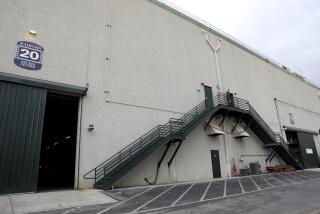Fire Not Cause of Death in Accident : Titan booster: Technician was killed by falling boxes of sand used to counterweight crane carrying rocket motor, officials say. A segment of the rocket fell and burst into flames.
EDWARDS AIR FORCE BASE — The civilian technician who died when a Titan 4 rocket motor segment being transported by a crane fell and burst into flames at a test laboratory here was killed by falling containers of sand used as a counterweight for the giant crane, officials said Saturday.
Investigators for the Air Force Space Division and Cal/OSHA, the state job safety agency, spent the day combing the site at the base’s Astronautics Laboratory trying to determine the cause of the Friday morning accident.
Nine other workers were injured, none seriously, when the segment of a Titan 4 Advanced Solid Rocket motor fell 70 feet, slid another 70 feet down a desert hillside onto a concrete fire containment basin, and erupted in a fire that sent a cloud of smoke billowing over the Mojave Desert.
Investigators were trying to determine whether mechanical or human error caused the 30-foot-long motor segment to fall as the heavy-duty boom crane, which stands about 400 feet high, was removing it from an outdoor testing stand for transfer to an adjacent storage stand, officials said.
The motor did not detach from the crane; rather, it apparently fell when the crane’s boom collapsed, Air Force Col. Mike Havey said.
“We honestly do not know what caused the boom to lower,” Havey said. “There was no indication that anything was amiss.”
Officials believe the spectacular flash fire was caused by friction created as the motor segment slid down the hillside, Havey said. The 250,000 pounds of solid fuel burned in 60 seconds, Havey said, and firefighters spent the rest of the day hosing down the smoldering debris on the concrete apron designed for fire containment.
“It was fortuitous that it fell into an area that was fully containable,” Havey said.
The smell of the fire still permeated the air Saturday at the desert ridge housing the lab, known as “the Rock,” one of the Air Force’s most prominent rocket development sites.
The wreckage of the crane lay crumpled across the hillside near the spot where tons of falling concrete and sand killed 27-year-old Alan M. Quimby of Lancaster, whose body was pulled from the rubble about 6:30 p.m. Friday.
Quimby worked for Wyle Laboratories, a subcontractor that operates the test site, Havey said. The rocket is built by Martin Marietta Corp. of Denver and the motor by a Utah-based subcontractor, Hercules Corp., which was supervising Friday’s operation, officials said.
At the time of the accident Quimby had been laying plywood on which the tractor-like treads of the crane advance, said Jim Malouf, chief coroner’s investigator. Quimby was among a team of 15 “safety spotters” monitoring the movement of the crane, Air Force officials said.
When the crane toppled, the van-sized containers, which serve as a counterweight on the crane platform at the base of the boom, fell and buried Quimby in sand and concrete, officials said.
“It was probably some type of crushing death or suffocation,” Malouf said. “He had a lot of injuries. He appears to have been killed instantly.”
Malouf said the fire was not the cause of death.
Quimby was described by a family friend Saturday as an outgoing man who was studying to become an architect and whose wife of four years is pregnant with the couple’s first child. He moved to the Antelope Valley in November.
Two other workers who were burned by flying debris spent the night at Antelope Valley Hospital Medical Center and were released Saturday. The other injured included civilian workers and a military firefighter who suffered cuts, fractures and smoke inhalation. They were treated and released Friday.
Cal/OSHA officials were trying to determine who was in charge at the lab site at the time of the accident, a task complicated by the mix of private contractors, subcontractors and military personnel working on the project, Cal/OSHA spokesman Rick Rice said.
“We are not focusing on any one employer,” Rice said.
The state agency was also checking whether the crane had received proper safety checks required by state law, Rice said. Any crane with more than a three-ton capacity must receive a safety certificate from private inspectors designated by Cal/OSHA, he said.
State workplace safety inspectors had not received any complaints about problems at the Astronautics Laboratory or visited the site during the last year, Rice said.
The agency has stepped up its review of crane safety as the result of numerous accidents involving cranes during the last several years and complaints that the agency and state-designated private inspectors were lax in enforcement.
The Air Force investigation will take at least three months and the Cal/OSHA inquiry at least three weeks, officials said.
Times staff writer Amy Louise Kazmin contributed to this story.
More to Read
Sign up for Essential California
The most important California stories and recommendations in your inbox every morning.
You may occasionally receive promotional content from the Los Angeles Times.









